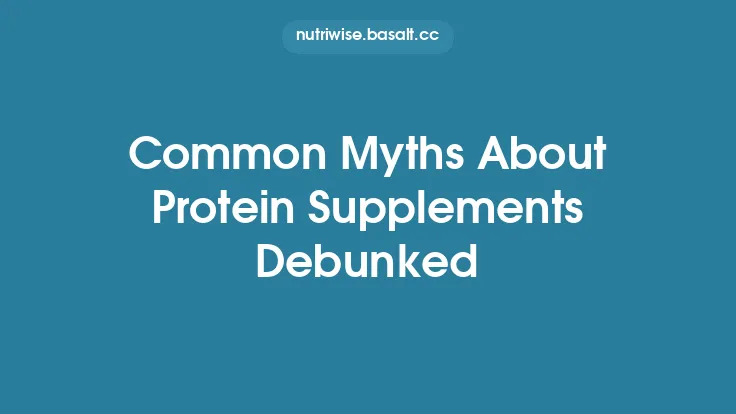Protein has become one of the most talked‑about nutrients in modern nutrition discourse. From fitness magazines to social‑media influencers, you’ll encounter bold claims about how much you should eat, when you should eat it, and what will happen to your body if you get it “wrong.” While some advice is grounded in solid science, a great deal of it is myth‑driven, leading to confusion, unnecessary worry, and sometimes counter‑productive eating habits. Below we dissect the most persistent misconceptions about protein intake, explain why they persist, and present the evidence‑based reality that can help you make informed choices without getting tangled in hype.
Myth 1 – “High Protein Diets Damage the Kidneys”
One of the longest‑standing fears is that consuming large amounts of protein will overwork the kidneys and eventually cause renal failure. This belief stems from early studies on patients with pre‑existing kidney disease, where protein restriction was shown to slow disease progression. However, extrapolating those findings to healthy individuals is scientifically inaccurate.
In healthy kidneys, the organ’s filtration capacity (glomerular filtration rate) adapts to increased nitrogenous waste from protein metabolism without structural damage. Large‑scale epidemiological studies involving thousands of participants have consistently found no association between high protein intake (even >2 g kg⁻¹ day⁻¹) and reduced kidney function in people with normal renal health. The kidneys do excrete more urea when protein intake rises, but this is a normal physiological response rather than a sign of pathology.
Takeaway: For individuals with normal kidney function, a high‑protein diet is not a risk factor for kidney disease. Those with diagnosed renal impairment should follow medical guidance, but the myth does not apply to the general population.
Myth 2 – “More Protein Automatically Means More Muscle”
The equation “protein + more = more muscle” oversimplifies a complex physiological process. Muscle hypertrophy requires three primary components:
- Mechanical tension (resistance training or other overload stimulus)
- Adequate amino acid availability to support protein synthesis
- Hormonal and cellular signaling that orchestrates the remodeling process
If any of these pillars is missing, simply increasing protein intake will not produce additional muscle mass. Moreover, the body has a ceiling for how much muscle protein synthesis (MPS) can be stimulated in a given period. Research using tracer techniques shows that, after a resistance session, MPS plateaus after roughly 20–30 g of high‑quality protein in most adults. Consuming extra protein beyond that point does not further elevate MPS; the excess is oxidized for energy or used for other metabolic needs.
Takeaway: Protein is a necessary substrate for muscle growth, but without the appropriate mechanical stimulus, extra protein alone will not generate additional muscle tissue.
Myth 3 – “Protein Supplements Are Essential for Everyone”
The supplement industry markets protein powders, bars, and ready‑to‑drink shakes as indispensable tools for meeting daily protein goals. While these products can be convenient, they are not a nutritional necessity for the majority of people.
Whole‑food sources—such as legumes, dairy, meat, fish, nuts, and seeds—provide protein along with a matrix of micronutrients, fiber, and bioactive compounds that supplements lack. For most adults with a balanced diet, meeting protein requirements through food alone is entirely feasible. Supplements become truly valuable in specific contexts:
- Athletes with very high protein targets (e.g., >2.2 g kg⁻¹ day⁻¹) where food volume becomes impractical.
- Individuals with limited appetite or chewing difficulties (e.g., elderly patients, post‑surgical recovery).
- People following restrictive diets where certain protein‑rich foods are excluded for medical or ethical reasons.
Even in these scenarios, the supplement should complement—not replace—whole foods.
Takeaway: Protein supplements are a practical option for convenience or special circumstances, but they are not a universal requirement for adequate protein intake.
Myth 4 – “Excess Protein Is Stored as Fat”
A common misunderstanding is that any protein beyond immediate needs is automatically converted into body fat. While the body can indeed convert amino acids into fatty acids through a process called de novo lipogenesis (DNL), this pathway is metabolically inefficient and typically only activated under conditions of chronic caloric surplus.
When protein intake exceeds the amount needed for tissue maintenance and repair, the surplus amino acids are first de‑aminated, producing carbon skeletons that can be used for gluconeogenesis (glucose production) or oxidized for energy. Only when total energy intake (from all macronutrients) surpasses expenditure does the body store excess calories as adipose tissue, regardless of whether those calories originated from protein, carbohydrate, or fat.
Takeaway: Protein is not uniquely prone to being stored as fat; excess calories from any source can lead to fat gain if energy balance is positive. In a calorie‑controlled diet, additional protein is more likely to be oxidized for energy or used in metabolic processes rather than converted to fat.
Myth 5 – “You Must Consume Protein Every Time You Eat”
The notion that each meal must contain a specific amount of protein to “keep the muscle clock ticking” has been popularized by fitness influencers, but the scientific evidence does not support a strict per‑meal requirement for the general population.
Protein metabolism is dynamic. The body maintains a circulating pool of amino acids that can be drawn upon between meals. While distributing protein intake across the day can modestly improve the efficiency of muscle protein synthesis in athletes, for most people the total daily protein intake is the dominant factor. Studies comparing evenly spaced protein meals versus skewed patterns (e.g., larger protein dinner, smaller breakfast) have shown negligible differences in overall nitrogen balance for non‑athletic adults.
Takeaway: For everyday health, focusing on meeting your total daily protein target is more important than ensuring a precise protein dose at every single meal.
Myth 6 – “Protein Is Only Important for Athletes and Bodybuilders”
Because protein is heavily featured in sports nutrition, many assume its relevance is limited to performance‑oriented individuals. In reality, protein plays critical roles across virtually every physiological system:
- Enzymatic activity: Most enzymes are proteins that catalyze biochemical reactions.
- Immune function: Antibodies and many cytokines are protein‑based.
- Hormonal regulation: Hormones such as insulin, glucagon, and growth hormone contain peptide structures.
- Structural integrity: Collagen, keratin, and elastin provide the framework for skin, hair, nails, and connective tissue.
These functions are essential for health at all ages, not just for those seeking to enhance athletic performance.
Takeaway: Adequate protein intake supports a wide array of bodily processes beyond muscle building, making it a cornerstone of overall health for everyone.
Myth 7 – “All Protein Powders Are Unsafe or Contain Harmful Additives”
Consumer apprehension about protein powders often centers on fears of contaminants, heavy metals, or artificial sweeteners. While quality can vary among brands, the majority of commercially available powders undergo rigorous testing for purity and safety.
Key points to consider when selecting a protein supplement:
- Third‑party certification: Look for seals from organizations such as NSF Certified for Sport, Informed‑Sport, or USP, which verify label accuracy and test for contaminants.
- Ingredient transparency: Products that list all ingredients, including the source of protein (e.g., whey isolate, pea protein), and avoid proprietary blends make it easier to assess nutritional content.
- Additive profile: Some powders contain added enzymes, digestive aids, or natural flavorings, which are generally recognized as safe. If you have sensitivities, choose “unflavored” or “minimal‑additive” options.
Regulatory agencies (e.g., FDA in the United States) monitor dietary supplements, and adverse event reports are relatively rare when consumers adhere to recommended dosages.
Takeaway: Protein powders are not inherently unsafe; choosing reputable, third‑party‑tested products mitigates most concerns about contaminants or harmful additives.
Myth 8 – “Protein Intake Has No Impact on Long‑Term Health”
Some narratives claim that protein is a “neutral” macronutrient, implying that its consumption does not influence chronic disease risk or longevity. Emerging research paints a more nuanced picture. Adequate protein intake has been linked to:
- Preservation of lean body mass during aging, reducing sarcopenia risk.
- Bone health: Protein stimulates insulin‑like growth factor‑1 (IGF‑1), which supports bone remodeling.
- Metabolic health: Sufficient protein can aid glycemic control by moderating postprandial glucose excursions, especially when paired with fiber‑rich foods.
Conversely, extremely low protein intakes (<0.5 g kg⁻¹ day⁻¹) are associated with increased frailty, impaired wound healing, and higher mortality in older adults. While the optimal range varies with age, activity level, and health status, the evidence underscores protein’s role in maintaining functional health across the lifespan.
Takeaway: Protein is more than a building block for muscle; it contributes to multiple aspects of long‑term health, making adequate intake a vital component of a balanced diet.
Bottom Line
Dispelling myths about protein helps you focus on what truly matters: meeting your individualized protein needs through a varied diet, using supplements only when they add convenience or address specific circumstances, and recognizing protein’s broad physiological importance. By grounding your choices in evidence rather than hype, you can enjoy the benefits of protein without unnecessary worry or over‑restriction.





